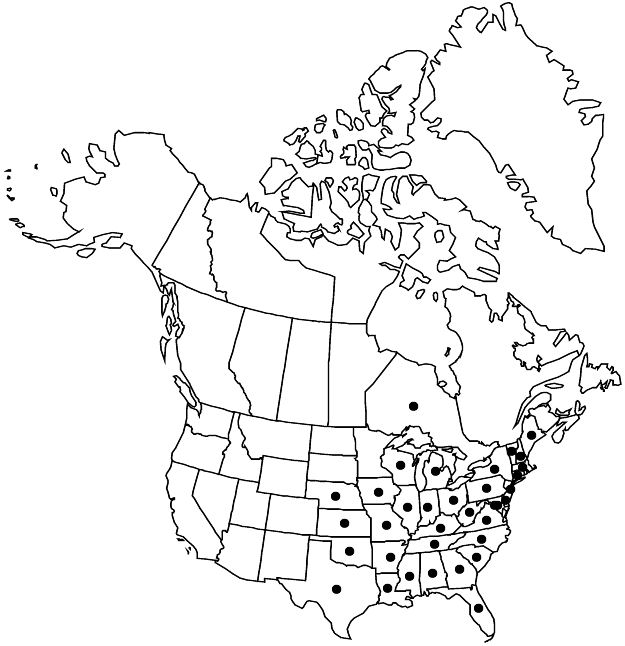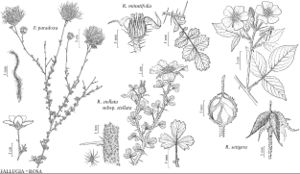Rosa setigera
Fl. Bor.-Amer. 1: 295. 1803.
Stems erect to procumbent and vinelike, 10–20 (–60) dm; bark of canes green to light-brown; prickles infrastipular and internodal, single or paired, declined, usually curved, sometimes erect, stout, 3–4 × 7–9 mm, broad-based, sometimes mixed with aciculi, rarely absent. Leaves deciduous, 8–12 cm; stipules narrowly lanceolate, 12–15 × 0.5–3 mm, auricles flared, 3–4 mm, margins entire, sometimes fimbriate, stipitate-glandular, surfaces glabrous, sparsely glandular; petiole and rachis with or without pricklets, usually pubescent, stipitate-glandular; leaflets 3 (mostly younger stems) –5 (older stems), terminal: petiolule 10–16 mm, blade ovate to elliptic-ovate, (30–) 48 (–70) × (20–) 27 (–40) mm, membranous or leathery, base rounded or obtuse, margins 1 (–2) -serrate, teeth (18–) 35 (–42) per side, coarse, gland-tipped, apex usually acuminate, abaxial surfaces pale green, glabrous or pubescent to tomentose, sometimes sessile and/or stipitate-glandular, adaxial darker green, dull, glabrous. Panicles (1–) 6 (–15+) -flowered. Pedicels 15–25 mm, glabrous, stipitate-glandular; bracts 1 or 2, narrowly lanceolate, 10–30 × 1–2 mm, margins short-stipitate-glandular, surfaces glabrous, eglandular. Flowers functionally unisexual or monoecious, plants dioecious, 3–5 cm diam.; hypanthium ovoid, 4–6 × 4–5 mm, stipitate-glandular; sepals narrowly to broadly ovatelanceolate, 10–18 × 2–4 mm, margins entire, tip 3–4 × 0.5–1 mm, abaxial surfaces pubescent, stipitate-glandular; petals single, rose-purple to pink, fading to white, 18–25 × 16–25 mm; stamens 212; carpels 20–25, styles glabrous, exsert 5–6 mm beyond stylar orifice rims (0.5 mm diam.), hypanthial disc 2–3 mm diam. Hips bright red, subglobose to globose, 6–10 × 6–9 mm, firm, sparsely stipitate-glandular often undeveloped because of dioecy, then early deciduous. Achenes 17–22, fawn, 4–5 × 2.5–3 mm. 2n = 14.
Phenology: Flowering May–Aug.
Habitat: Prairies, savannas, woodland borders, clearings, open fields, abandoned pastures, waste areas, roadsides, fence rows
Elevation: 100–500 m
Distribution

Ont., Ala., Ark., Conn., Del., D.C., Fla., Ga., Ill., Ind., Iowa, Kans., Ky., La., Maine, Md., Mass., Mich., Miss., Mo., Nebr., N.H., N.J., N.Y., N.C., Ohio, Okla., Pa., S.C., Tenn., Tex., Vt., Va., W.Va., Wis., in Europe (Channel Islands)
Discussion
In the eastern United States Rosa setigera has been introduced from the Midwest or escaped from cultivation (W. H. Lewis 1959b). Based primarily on herbarium records, R. setigera is introduced in Connecticut, Delaware, District of Columbia, Florida, Louisiana, Maine, Maryland, Massachusetts, Mississippi, New Hampshire, New Jersey, North Carolina, South Carolina, Vermont, and Virginia; other states (Alabama, Georgia, New York, Pennsylvania, West Virginia) probably have both native and introduced populations.
Rosa setigera is the only native rose with procumbent or climbing stems to 60 dm with three leaflets on younger stems and five on older stems, and with unisexual flowers and caducous sepals.
Rosa setigera is the only species of sect. Systylae native to North America. The species is distinct from other members of the section in its flavonoid patterns, which show linkages to sect. Cinnamomeae [= sect. Rosa] (C. Grossi et al. 1998); it is also the only dioecious species of the genus. Microscopic floral characters are detailed elsewhere (W. H. Lewis 1959b; P. G. Kevan et al. 1990; J. R. Kemp et al. 1993, 1993b).
Since 1886, Rosa setigera has been used also as one parent in climbing hybrid cultivars produced in central Europe to increase hardiness and vigorous growth.
Selected References
None.
Lower Taxa
"dm" is not declared as a valid unit of measurement for this property."dm" is not declared as a valid unit of measurement for this property."dm" is not declared as a valid unit of measurement for this property.
